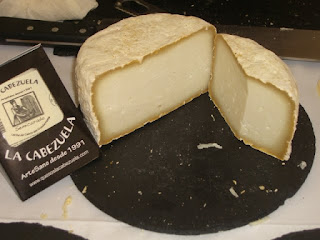This is my first time to Slow Food’s Cheese! expo, and I'm really excited. Cheese is amazing when you think about it: milk that is edible weeks/months later? Think about the first people who figured this out and could make the efforts of their goats/sheep/cows/camels portable and durable.
This expo is all about small, local producers who have come from all over the world to keep artisan cheesemaking going and growing. Incidentally, the exclamation mark in the name is NOT mine, though I’m prone to use punctuation with enthusiasm. Anyway, I definitely understand the sentiment.
I’ve come into Bra (yes, that’s the name of this town in northern Italy, an hour south of Torino/Turin, hometown of Slow Food founder Carlo Petrini). Today is a day away from the farm, though as I look down at my one pair of decent pants I notice that I’ve brought plenty of the farm with me. Don’t know if it’s dust from the hay, goat dander, or your basic dirt, but this fatal flaw in my dress might be the one thing that sets me apart as non-Italian. Ha!
Enough about that. Let’s talk about cheese. After the first day, I have made it through only a tiny part of the outdoor exhibition area, but have met interesting people whose lives are devoted to this living, breathing food that we love. I miss Michael more than usual here, because I know how much my food geek husband would love this!
 |
| Blue cheese aged in cherry schnapps barrels |
The first stand I visited was a Swiss one called Tumi from the Emmenthal region, and they were determined to show the world that Emmenthal cheese isn’t just the yummy fondue variety. In fact, they were rather unusual in that they produce an enormous range of cheese types from blue to bloomy rind to hard grating styles. The range is unusual, primarily because it's especially easy for the molds in blue cheese to contaminate other cheese. These folks make the blue in a separate facility.
One of my favorites of the whole show is their blue cheese (left) aged in the barrels used to make cherry schnapps. From the schapps, it has a hint of sweetness which goes well with the sharp, salty blue flavor.
One of my favorites of the whole show is their blue cheese (left) aged in the barrels used to make cherry schnapps. From the schapps, it has a hint of sweetness which goes well with the sharp, salty blue flavor.
 |
| Peppery cheese for grating--imagine it over beef carpacchio, pasta, salads. Yum!! |
This one is another favorite; its flavor is so strong that it is used by slicing it very, very finely, like a truffle. Kind of looks like a truffle too! It's a hard, round crumbly cheese (right) with a really strong pepper taste, used for grating over things like beef carpacchio—a little goes a long way!
I stopped at a booth called “The Best of Spain,” run by a group of several producers who band together to share the costs of promotion, like booth rental fees, etc. I spoke with Juan Luis Royuela, a goat cheese maker from “La Cabezuela,” located outside Madrid. He’d brought three varieties and was clearly passionate about Spanish cheese. I really enjoyed talking to all of these producers, but I had a hard time trying to speak Spanish after working so hard at Italian these past few days!
But back to cheese: part of what has been great about this show (besides tasting more cheese than my tastebuds can handle) is learning about techniques in cheesemaking. The tiniest variation in production method can make an enormous difference in the final product.
But back to cheese: part of what has been great about this show (besides tasting more cheese than my tastebuds can handle) is learning about techniques in cheesemaking. The tiniest variation in production method can make an enormous difference in the final product.
For example, check this out: the two “La Cabezuela” cheeses below are made from the same goat milk, same rennet and same introduced molds, and they’re aged for the same length of time (two months). The first one is drier, crumbly and fairly hard; the second one is smooth, creamy, soft and somewhat elastic. The only differences (aside from mold shape) are only the temperature and humidity during the aging process (see captions).
 |
| Aged at 15° C in 90% humidity |
 |
| Aged at 8° C in 80% humidity |
That's it for now: more Cheese! tomorrow...

No comments:
Post a Comment